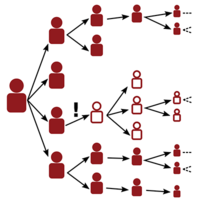当前位置:
X-MOL 学术
›
Phys. Rev. Research
›
论文详情
Our official English website, www.x-mol.net, welcomes your
feedback! (Note: you will need to create a separate account there.)
Descendant distributions for the impact of mutant contagion on networks
Physical Review Research ( IF 3.5 ) Pub Date : 2020-07-01 , DOI: 10.1103/physrevresearch.2.033005 Jonas S. Juul , Steven H. Strogatz
Physical Review Research ( IF 3.5 ) Pub Date : 2020-07-01 , DOI: 10.1103/physrevresearch.2.033005 Jonas S. Juul , Steven H. Strogatz

|
Contagion, broadly construed, refers to anything that can spread infectiously from peer to peer. Examples include communicable diseases, rumors, misinformation, ideas, innovations, bank failures, and electrical blackouts. Sometimes, as in the 1918 Spanish flu epidemic, a contagion mutates at some point as it spreads through a network. Here, using a simple susceptible-infected model of contagion, we explore the downstream impact of a single mutation event. Assuming that this mutation occurs at a random node in the contact network, we calculate the distribution of the number of “descendants,” , downstream from the initial “patient zero” mutant. We find that the tail of the distribution decays as for complete graphs, random graphs, small-world networks, networks with block-like structure, and other infinite-dimensional networks. This prediction agrees with the observed statistics of memes propagating and mutating on Facebook and is expected to hold for other effectively infinite-dimensional networks, such as the global human contact network. In a wider context, our approach suggests a possible starting point for a mesoscopic theory of contagion. Such a theory would focus on the paths traced by a spreading contagion, thereby furnishing an intermediate level of description between that of individual nodes and the total infected population. We anticipate that contagion pathways will hold valuable lessons, given their role as the conduits through which single mutations, innovations, or failures can sweep through a network as a whole.
中文翻译:

突变传播对网络影响的后代分布
广义上讲,传染是指任何可以在同伴之间传播的传染性物质。例子包括传染病,谣言,错误信息,想法,创新,银行倒闭和电力中断。有时,例如在1918年西班牙流感疫情中,传染病会在某种程度上通过网络传播而发生变异。在这里,我们使用简单的易受感染的传染模型,探索单个突变事件的下游影响。假设此突变发生在联系网络中的随机节点上,我们计算“后代”数量的分布,,位于初始“患者零”突变体的下游。我们发现分布的尾部衰减为适用于完整图,随机图,小世界网络,具有块状结构的网络以及其他无限维网络。这一预测与在Facebook上传播和变异的模因的观测统计数据吻合,并有望适用于其他有效的无穷维网络,例如全球人类接触网络。在更广泛的背景下,我们的方法为介观传染理论提供了可能的起点。这种理论将集中在传播蔓延所追踪的路径上,从而在单个节点的描述和总感染人群之间提供中等水平的描述。我们认为,由于传染途径是单个突变,创新或失败可以贯穿整个网络的渠道,因此传染途径将获得宝贵的教训。
更新日期:2020-07-01
中文翻译:

突变传播对网络影响的后代分布
广义上讲,传染是指任何可以在同伴之间传播的传染性物质。例子包括传染病,谣言,错误信息,想法,创新,银行倒闭和电力中断。有时,例如在1918年西班牙流感疫情中,传染病会在某种程度上通过网络传播而发生变异。在这里,我们使用简单的易受感染的传染模型,探索单个突变事件的下游影响。假设此突变发生在联系网络中的随机节点上,我们计算“后代”数量的分布,,位于初始“患者零”突变体的下游。我们发现分布的尾部衰减为适用于完整图,随机图,小世界网络,具有块状结构的网络以及其他无限维网络。这一预测与在Facebook上传播和变异的模因的观测统计数据吻合,并有望适用于其他有效的无穷维网络,例如全球人类接触网络。在更广泛的背景下,我们的方法为介观传染理论提供了可能的起点。这种理论将集中在传播蔓延所追踪的路径上,从而在单个节点的描述和总感染人群之间提供中等水平的描述。我们认为,由于传染途径是单个突变,创新或失败可以贯穿整个网络的渠道,因此传染途径将获得宝贵的教训。











































 京公网安备 11010802027423号
京公网安备 11010802027423号